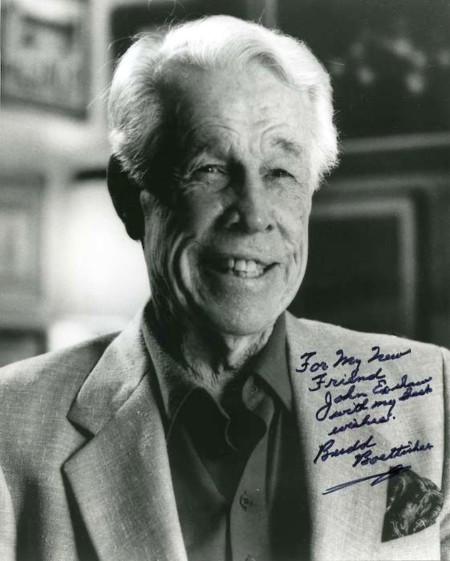Budd Boetticher (Oscar Boetticher)

Budd Boetticher was born in Chicago, raised in Evansville in southwest Indiana, and was a star athlete at Ohio State University. After college he traveled to Mexico, where he learned the art of bullfighting. A chance encounter with Rouben Mamoulian landed him his first film job, as technical advisor on Blood and Sand (1941). He got his first big break when he was asked to direct The Bullfighter and the Lady for John Wayne’s production company, Batjac, based loosely on his own adventures studying to be a matador in Mexico. He was proud enough of the film that it was the first he signed as “Budd Boetticher,” rather than his given name, and it earned him an Oscar nomination for Best Original Story. But the film was edited drastically without his consent, and his career again seemed on hold. (The film has since been restored by the UCLA Film Archive and the restored print is sometimes referred to by its working title, Torero.) Soon after, he signed a contract at Universal and directed a number of program pictures, including The Man from the Alamo, the 3-D western Wings of the Hawk and Red Ball Express, a WW2 drama noteworthy for its integrated cast (including Sidney Poitier). In 1955, he helmed another bullfighting drama, The Magnificent Matador, at 20th Century-Fox, which began his frequent collaboration with cinematographer Lucien Ballard, followed by a trim film noir, The Killer Is Loose, for United Artists. He also directed the first three episodes of the TV series Maverick.
Budd Boetticher finally achieved his major breakthrough when he teamed up with actor Randolph Scott, producer Harry Joe Brown and screenwriter Burt Kennedy to produce the seven films (last in 1960) that came to be known as the Ranown Cycle. Budd Boetticher spent most of the 1960s south of the border pursuing his obsession, the documentary of his friend, the bullfighter Carlos Arruza, turning down profitable Hollywood offers and suffering humiliation and despair to stay with the project, including sickness, bankruptcy and confinement in both jail and asylum (all of which is detailed in his autobiography When in Disgrace). It was finally released in the USA as “Arruza” in 1971. In 1960, the director made a departure from Western films for The Rise and Fall of Legs Diamond, the story of a high-rolling gambler, starring Ray Danton, loosely based on the lives of Jack Diamond and Arnold Rothstein. The rest of Boetticher’s output since 1960 consists of the rarely seen A Time for Dying (a collaboration with Audie Murphy released in 1971), the story for Don Siegel’s Two Mules for Sister Sara (1970), the documentary My Kingdom For… (1985) and his appearance as a judge in Robert Towne’s Tequila Sunrise (1988), and he was still actively attempting to get his screenplay “A Horse for Mr. Barnum” made, before his death in 2001. He and his wife Mary spent much of their later years traveling to film festivals around the world, especially in Europe. His last public appearance, less than three months before his death, was at Cinecon, a classic film festival held in Hollywood, CA.
Born
- July, 29, 1916
- USA
- Chicago, Illinois
Died
- November, 29, 2001
- USA
- Ramona, California
Other
- Cremated



